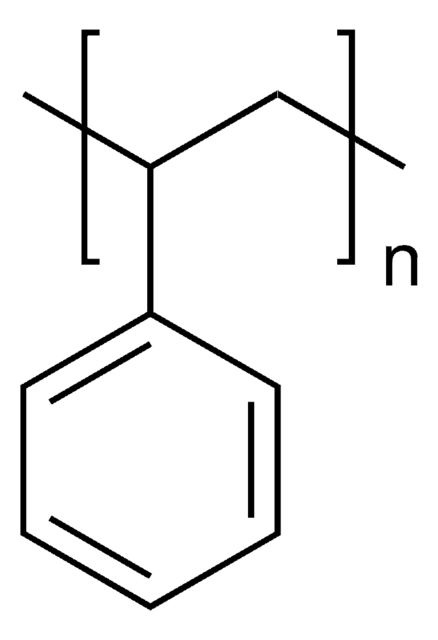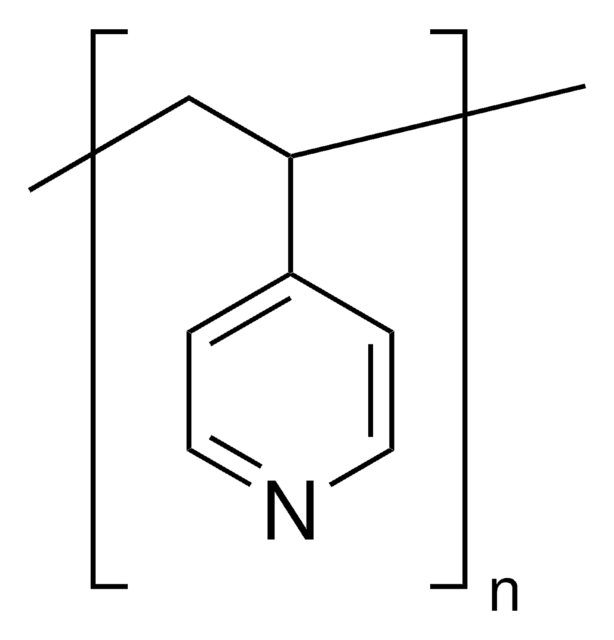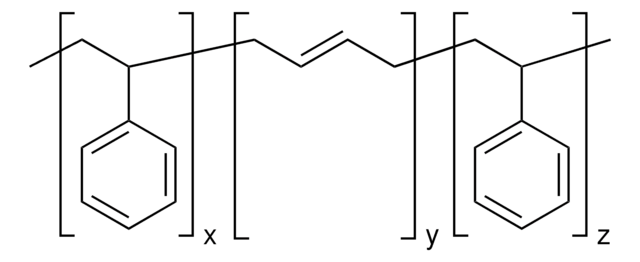430102
Polystyrene
average Mw ~192,000
Sinonimo/i:
PS
Autenticatiper visualizzare i prezzi riservati alla tua organizzazione & contrattuali
About This Item
Formula condensata:
[CH2CH(C6H5)]n
Numero CAS:
Numero MDL:
Codice UNSPSC:
12162002
ID PubChem:
NACRES:
NA.23
Prodotti consigliati
Stato
beads or pellets
Livello qualitativo
Indice di fluidità
6.0-9.0 g/10 min (200°C/5kg)
PM
average Mw ~192,000
Indice di rifrazione
n20/D 1.59
Temp. transizione
softening point 107 °C (Vicat, ASTM D 1525)
Stringa SMILE
c1(ccccc1)C=C
InChI
1S/C8H8/c1-2-8-6-4-3-5-7-8/h2-7H,1H2
PPBRXRYQALVLMV-UHFFFAOYSA-N
Cerchi prodotti simili? Visita Guida al confronto tra prodotti
Categorie correlate
Descrizione generale
Hard, clear moderately strong polymer, biologically inert, good dimensional stability. Susceptible to exterior (UV) degradation.
Applicazioni
Extrusion molded foamed packaging, dinnerware, bottles and toys. Injection molded packaging containers, toys and disposable cutlery.
Stato fisico
Thermoplastic amorphous polymer.
Codice della classe di stoccaggio
11 - Combustible Solids
Classe di pericolosità dell'acqua (WGK)
WGK 3
Punto d’infiammabilità (°F)
Not applicable
Punto d’infiammabilità (°C)
Not applicable
Dispositivi di protezione individuale
Eyeshields, Gloves, type N95 (US)
Scegli una delle versioni più recenti:
Possiedi già questo prodotto?
I documenti relativi ai prodotti acquistati recentemente sono disponibili nell’Archivio dei documenti.
I clienti hanno visto anche
Dharneedar Ravichandran et al.
Molecules (Basel, Switzerland), 24(22) (2019-11-17)
Polystyrene (PS) polymers have broad applications in protective packaging for food shipping, containers, lids, bottles, trays, tumblers, disposable cutlery and the making of models. Currently, most PS products, such as foams, are not accepted for recycling due to a low
Marta Kocun et al.
ACS nano, 11(10), 10097-10105 (2017-09-28)
Tapping mode atomic force microscopy (AFM), also known as amplitude modulated (AM) or AC mode, is a proven, reliable, and gentle imaging mode with widespread applications. Over the several decades that tapping mode has been in use, quantification of tip-sample
Hui Xia et al.
Journal of colloid and interface science, 376(1), 322-326 (2012-03-27)
The aggregation kinetics of particles in dense polystyrene latex suspensions is studied by low-coherence fiber optic dynamic light scattering. Low-coherence fiber optic dynamic light scattering is used to measure the hydrodynamic radius of the aggregates. The aggregation kinetics data obtained
Harikrishnan Narayanan Unni et al.
Electrophoresis, 30(5), 732-741 (2009-03-05)
This study reports a theoretical and experimental study on the irreversible deposition of colloidal particles from electrokinetic microfluidic flow. The electrokinetic particle transport model presented in this study is based on the stochastic Langevin equation, incorporating the electrical, hydrodynamic, Derjaguin-Landau-Verwey-Overbeek
Liang Zhang et al.
Journal of colloid and interface science, 353(2), 557-561 (2010-10-30)
Reported are adsorption isotherms for guar and hydroxypropyl guar (HPG), with and without the presence of borate ions, onto surfactant free anionic polystyrene latex. Guar and HPG formed adsorbed monolayers on the hydrophobic latex. The presence of borate ions converted
Global Trade Item Number
| SKU | GTIN |
|---|---|
| 430102-1KG | 4061832107813 |
| 430102-3KG | 4061832107820 |
Il team dei nostri ricercatori vanta grande esperienza in tutte le aree della ricerca quali Life Science, scienza dei materiali, sintesi chimica, cromatografia, discipline analitiche, ecc..
Contatta l'Assistenza Tecnica.



